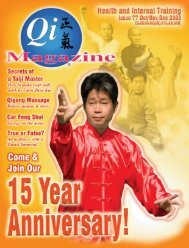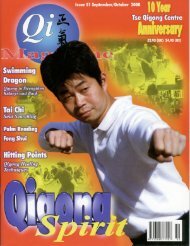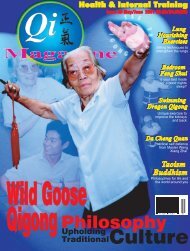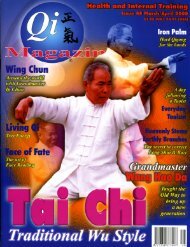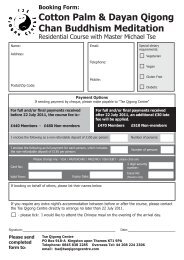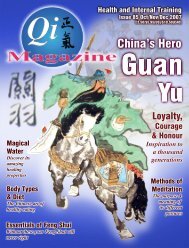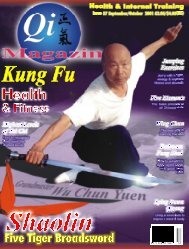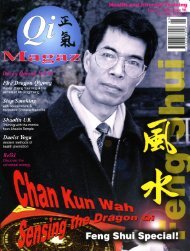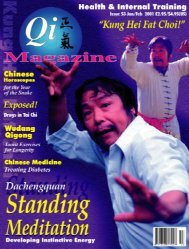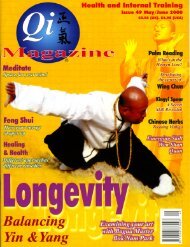Issue 54 - Tse Qigong Centre
Issue 54 - Tse Qigong Centre
Issue 54 - Tse Qigong Centre
- No tags were found...
Create successful ePaper yourself
Turn your PDF publications into a flip-book with our unique Google optimized e-Paper software.
Tendon and Peanut SoupThe Chinese believe that when you have a deficiency or problem with a particular organ or part of the body, then if youeat the corresponding animal organs or parts, then this will strengthen your own. As we age, it is easy for us to move less and soour joints can become stiffer and the bones drier and more brittle from lack of blood circulation. This soup is very good forstrengthening the tendons, bones and for relieving rheumatism. It is made with dried tendons which are available at mostChinese supermarkets and also dried mussels which are good for arthritis, muscle aches and rheumatism as well. Peanuts aregood for the lungs and for revitalising energy by working on the kidneys. You can make this soup once or twice a month if youfind your bones are weakening or you have aching joints and muscles. It is also a very good soup for martial artists, helping tonourish the body.Ingredients:5 oz (150g) dried tendons10 oz (300g) peanuts (still in red skin, unsalted, raw)1 cup dried mussels16 cups water3 dried dates1 tsp salt1. Soak the tendons overnight in water and then cut them into 3 inch (8 cm) sections. Soak and peel the peanuts. Washand soak the dried mussels.2. Fill a pan with water and add mussels, dates, salt and tendons. Bring water to a boil and then reduce heat and simmerfor one and a half hours. Add peanuts and continue to simmer for another hour. Taste and add more salt if necessary.3. When serving, you can remove tendons and peanuts and use for another dish or you can eat with the soup as you wish.Book Review<strong>Qigong</strong> Exercise Therapy£13/95/$17.95I often wonder when I introduce new <strong>Qigong</strong> books to our readers, whether they questionwhether or not this conflicts with being told not to mix different <strong>Qigong</strong> styles and methods by theirteacher. Actually, I think most people understand and know why you should not mix different<strong>Qigong</strong> styles and would be careful to separate their practice if doing more than one method. Ipersonally look at different <strong>Qigong</strong> books as a method of reference for <strong>Qigong</strong> theory and philosophyrather than as a practice tool. Having said that, sometimes there are some techniques for simple<strong>Qigong</strong> massage or relaxation methods that are very useful and can be practised without harm.<strong>Qigong</strong> Exercise Therapy is more of a how-to book than a book on history or philosophy, although it does give aninteresting, though brief introduction, on <strong>Qigong</strong> with an emphasis on Chinese TCM theory of the body. I did find it interestinghow the author explained why <strong>Qigong</strong> can be said to make us smarter, saying that “the brain is the reservoir of the marrow”.Given the increasing instances of Alzheimers Disease, it is very interesting to see the importance of good kidney function, askidneys also relate to bone and marrow. If I can learn even one or two new ideas or points to help my students and also myselfunderstand <strong>Qigong</strong> better, I feel that I am continuing to develop my skill and feel that book is worth it.<strong>Qigong</strong> Exercise Therapy offers <strong>Qigong</strong> exercises to cover a wide range of illnesses and conditions, even a version of theCancer Walking exercises recently featured in Qi Magazine. They include internal diseases and illnesses such as impotence,vertigo, hernia, menopause, joint pain, headache, depression, asthma, etc. Most of the exercises have line illustrations, othersonly descriptions. This book covers many exercises in its nearly 300 pages, however, even in its last pages, it counsels finding aqualified teacher for guidance of practice. It says failure to do this, along with impatience for results, improper posture andbreathing and aimless change in the practice of various <strong>Qigong</strong> exercises can cause side effects. Many of the exercises are verysimple and involve sitting, standing or lying postures which can help a practitioner understand more about <strong>Qigong</strong> basics. Otherexercises are more complicated and should be considered carefully before practice.By Jessica BlackwellQi Magazine 30



